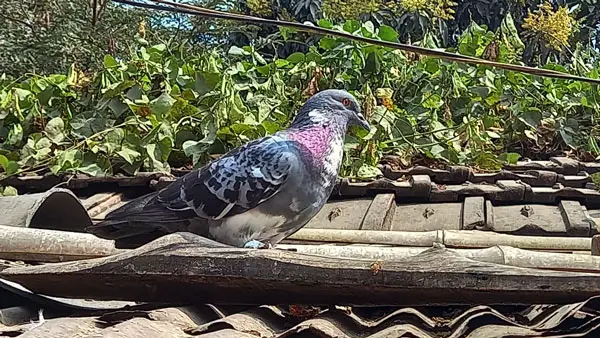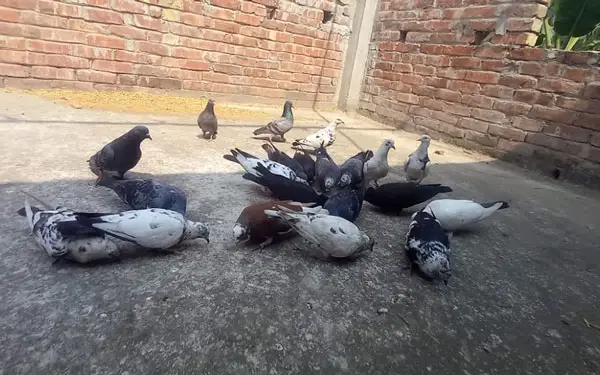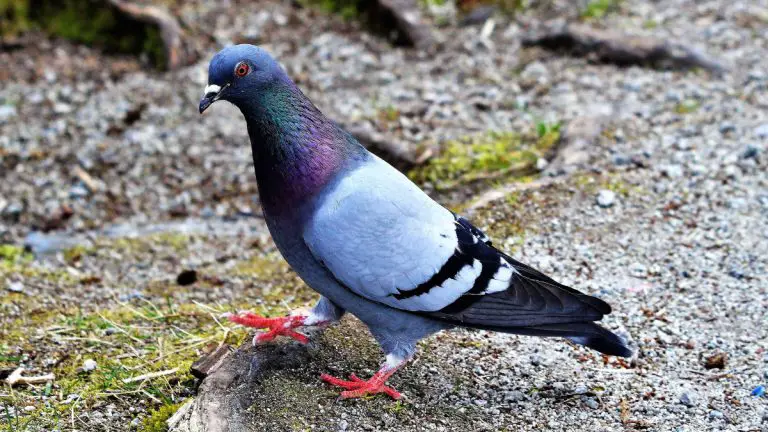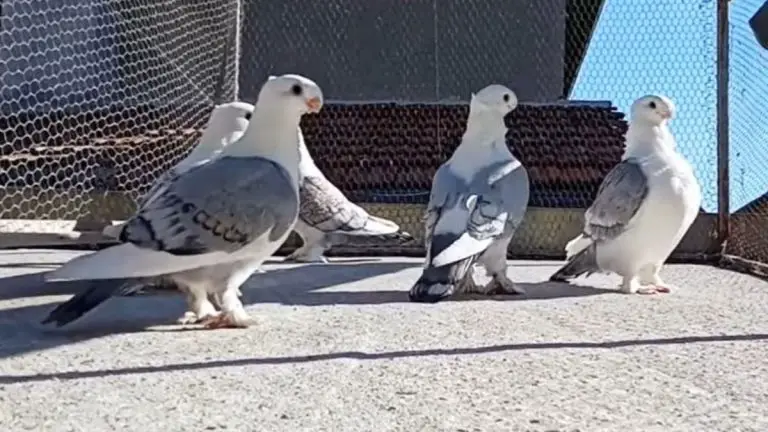Homer Pigeons: Origin, Appearance, Behavior, Care, And More
Homing pigeons are known for their unique ability to find their way back home from far, far away. They boast excellent homing instincts which enable them to always return home even when released from unfamiliar locations far from home.
This is the reason the birds found extensive use during times of war as they were sent to deliver messages. They’re also used in pigpen competitions, where they’re released and the first one to return to its loft takes the day. Quite interesting right?
In this article, you’ll discover more interesting facts about the homing pigeon including the various breeds of homers pigeons available, their appearance, temperament, etc. We’ll also offer you some helpful tips on how to train these birds the right way.
Homer pigeon Quick Facts:
| Scientific name | Columba livia domestica |
| Other names | Mail pigeon, Messenger pigeon |
| Breed name | Racing Homer |
| Breed purpose | Messaging, Racing, Exhibition, Pets |
| Size | Medium to Large |
| Weight | 250 to 600 grams |
| Flying ability | Excellent |
| Cost | $50 to $300+ |
| Lifespan | 10+ years |
Origin and history
The exact origin of homing pigeons is unclear, but they’re believed to have been domesticated by humans over 5000 years ago for food and messaging purposes.
Greeks are believed to be the ones who first noticed the birds’ homing abilities, and used them to deliver messages in Olympic games. The birds were also used by Romans, and Egyptians to carry messages over pretty long distances.

Note that there are several breeds of the homer pigeon, with the most common ones being the racing homers, exhibition homers, gigantic homers, and genuine homers.
Some of the homers used for racing purposes include German beauty homers, American racing homers, Belgian racing homers, English homing birds, and Squabbing Homers.
Today, these birds are still used in racing competitions, exhibitions, and as pets.
Appearance
A typical homing bird is average-sized with a slender body, with a simple but elegant appearance.
It has strong wings that are well adapted for long-distance flying, and its wingspan ranges from 60 to 70 centimeters. Its legs are usually reddish in color.
Its eyes are usually large and round and feature a black pupil in addition to an iris whose color varies depending on the breed.

The beak is usually short and curvy whole its tail is short and rounded, with approx. 12 feathers lined up in a fan-like design.
The bird comes in a wide variety of colors including gray, black, white, blue, and red. Though gray is the most common color.
Behavior
The homing pigeons have a calm and mild temperament which makes them a good choice for pigeon pets. They’re also social birds and you can mix them up with other birds in your loft.
Because they’re also intelligent birds with homing instincts, you can easily train them to come back home whenever you release them. The training can start from a pretty young age of around 6 weeks old.
Also, these birds are highly adaptable and will easily thrive in various environments, ranging from rural farmlands all the way to urban rooftops.
Diet
You should feed your homer pigeon a healthy and balanced diet that contains seeds, grains, vegetables, and fruits.
Most people opt to feed their pigeons commercial bird food which is perfectly okay. But it’s also advisable to introduce other types of food mentioned here to help add variety to your bird’s diet.
That said, you should ensure you feed your bird the amount of food it can consume in about 15 to 20 minutes, twice per day. After this feeding period is over, simply clean up and remove the leftovers.

Some folks also recommend grit for pigeons to help with digestion as well as supply minerals and vitamins. If you believe in grit, then you should offer it to your pigeons as well.
Make sure you provide your homer pigeons with clean and fresh water every day.
TIP: During training or racing sessions, feeding your bird more fats and carbohydrates helps give them sufficient energy to keep them going. During molting or breeding, the bird requires more proteins.
Habitat
If you plan to bring a homing pigeon home, then you should make sure you have a suitable living space for it before it even arrives at your doorstep.
A pigeon home, or loft, can vary in terms of size and configuration. You can make your own DIY loft or get a ready-made model. We recommend about 8-10ft cubic feet of space for every pair of homing pigeons you own.
An ideal pigeon habitat should keep the birds protected from potential predators such as cats, dogs, raccoons, hawks, etc. It should also have excellent ventilation and leave sufficient space for feeds and other necessary equipment.
If you plan to breed homing pigeons, then make sure you also set apart some nesting space for the breeding pairs and their chicks.
We advise placing your loft in an area free of any aerial obstructions. This will help avoid distractions that may deter your homers as they fly or when training them.
Homer pigeons as pets
Homer pigeon is a calm and friendly bird, which makes it a good pet. It’s also an intelligent bird that’s easy to train (check our training tips below).
However, you should be committed to taking good care of your newfound feathered friend to keep it happy and healthy.

Essentially, you should provide it with a balanced diet, keep its housing clean, provide it with clean and fresh water daily, and provide it with a comfortable and healthy living space.
We have already discussed the diet and housing requirements of this pigeon breed, so we won’t go into the details again.
Regular avian vet care is also essential for these birds. Vets can detect potential health issues early on and treat them as well as offer you helpful tips for keeping your birds healthy.
Price
The price of a homing pigeon can vary from $50 to a few hundred dollars, depending on factors such as the breed quality, the breeder, location, and overall bird health.
Generally, we advise you to get the highest-quality bird you can afford. Pigeons are usually bought in pairs, and you’d be better off buying a small number of high-quality pairs than many pairs of low-quality breeds.
If you’re buying a homing pigeon for racing, then you should mainly focus on the bird’s performance. Check the specific pigeon’s performance, the performance of its lineage, or the performance of that specific breed.
And if you’re buying a breed for shows/exhibition purposes, then you should get the bird on the confirmation basis as judges usually pick a winning bird by looking at a variety of physical characteristics.
You should also ensure you buy from a reputable breeder who has a history of the bird’s lineage, health certificates, and other necessary documentation about the bird.
Finding a reputable breeder (based on pedigree and performance) will help ensure you get the best quality birds possible.
Lifespan
The average lifespan of homing pigeons is around 10 years, though some individuals can live for up to 20 years. Factors that influence the lifespan of this pigeon include genetics (some breeds of homer pigeons tend to last longer), living conditions, diet, and overall health.

If you want to extend the lifespan of your homer pigeon, make sure you provide it with proper nutrition, comfortable living conditions, and routine vet checkups to help catch potential health issues early and treat them.
How to train a homing pigeon for beginners?
Training for homing pigeons can start when the birds are pretty young—from age of 6 to 8 weeks.
To train your homing pigeon to come home, take them about a mile away from home and then release them. Do this several times every week (do it daily, if possible).
Gradually increase the release distance. We recommend extending the distance to about or less than 5 miles every week. You should consider taking the birds in different directions before releasing them.
If you notice your birds having trouble finding their home, pause extending the release distance and stick to their last successful homing distance for some time.
Training the homing pigeons to come home isn’t easy and requires a lot of time and dedication.
Losing some of your birds in the process isn’t uncommon. If this happens, you may want to go slow on the training frequency and reduce the training distance for a while.
Watch the video below on how to teach your homers to come home
Video:
Final Verdict
Homing pigeons are an interesting breed of birds popular for their homing instincts. These birds always return home whenever they’re released over long distances. This made them quite helpful during the world wars as well as in ancient times in Greek, Rome, and Egypt where they were reliable carriers of messages over long distances.
Today, the homing birds are still used as messengers, though they’re mostly used for pigeon exhibitions, racing competitions, and pets. The pigeons are docile, social, and intelligent, and make good pigeon pets for beginners as well as enthusiasts who plan to add more breeds to their flocks.






